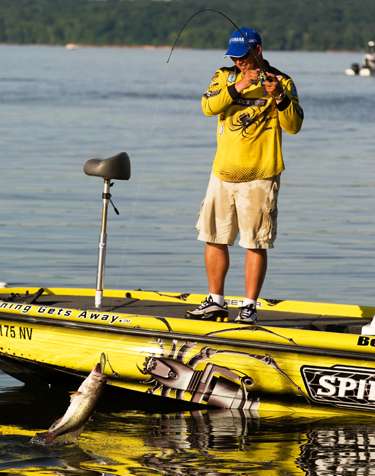
The spawn is a highly regional event, taking place at different times during the year. In the extreme south (Florida, mostly) fish can be found spawning as early as December with late spawners starting in February. Further north (south Georgia to the Mason-Dixon), the spawn kicks off in April and goes through early June. Further north still, the spawn can start as late as June and go through late July. Regardless of when the spawn is in your area, one thing is certain: It's your best chance at a trophy fish.
Here's how a pro from each region tackles the spawn and wrangles big bass from their love nests.
Extreme South: Bobby Lane, Florida
The mild weather of the Sunshine State can be a boon to bassers fishing the spawn. Florida pro Bobby Lane counts on cold fronts to produce some of the best spawn-time fishing anywhere.
"We're fortunate in Florida that the fronts don't always make it this far South, but if they do, the times between are without a doubt the best times for an 8-plus-pound fish," he says. "If you schedule your trip where there's a full moon, and it's in between cold fronts, your chances of getting a 10-pound fish are about 95 percent.
"If that's not good enough, if you get a couple of hot days around a full moon, you're almost guaranteed several fish over 8 pounds if you're looking in the right areas."
When searching for these nest-guarding lunkers, Lane starts at the north end of the lake. He reasons that the water will be clearer as the north winds whip up the south end, making it harder for both fish and anglers to see. If he's fishing in a pocket, he fishes the sunny side first — it's warmer.
When approaching a bedding bass, Lane makes sure three requirements are satisfied: He's using 50- to 65-pound-test SpiderWire Ultracast braid, his bait is bulky and it's a natural color. Using this combo, he has won thousands of dollars in tournaments and weighed in a 9-8 lunker, all in less-than-optimal spawn periods.
His final piece of advice?
"Leave your finesse stuff at the house. If you hit it right, these are great big fish moving up. You don't need to be throwing wimpy baits or light line," he says. "If you're catching small fish, don't leave that area. Go check somewhere else, but always come back to that area. They might not be there in the morning, but they'll be there in the afternoon."
South: Mike McClelland, Arkansas
Mike McClelland agrees that the spawning season is your best bet for nabbing those elusive lunkers, but he also says that you may have a better shot at a trophy bass before its bed time.
"I truly believe the biggest fish are the first to spawn, so in my region late March to early April is your best shot at a monster. By the time most fish are on beds, the big ones are guarding fry," he says. "In this case, a buzzbait or a swimbait is the ticket."
McClelland favors War Eagle's black and blue buzzbaits and a Spro BBZ-1 soft swimbait. He sticks to the spawning areas but targets areas close to deeper water. The harder the bottom, the better. Pea gravel, big gravel or a mixture are best.
Since bass of the same size typically run together, if you're catching small fish, that's probably all you're going to get. He reiterates the fact that spawning areas adjacent to deep water are lunkers' preferred spawn-time haunts.
If you're a night owl, McClelland says a lot of the biggest fish are caught in the nighttime hours during the spawn. If you do head out at night, take dark-colored buzzbaits and big, dark Colorado blade spinnerbaits.
North: Bill Lowen, Ohio
"Typically, when I'm looking for trophy fish, I'm looking for places where the fish can stage — especially where the big ones hang out before the spawn. These are usually secondary points, deeper banks that lead to the spawning flats. The big ones stay out a little further," he says. "If neither of these work, look for fish that are actually on the bed."
When working secondary points prespawn, Lowen likes moving baits such as spinnerbaits, buzzbaits, swimming jigs and crankbaits. The fish that aren't actively spawning are feeding heavily in preparation for the spawn.
For bedding fish, Lowen goes for small-profile baits like a Gitzit tube or a finesse worm with a light weight. When bed fishing, Lowen opts for 15- to 20-pound Trilene fluorocarbon on a flipping stick. He likes to use his flipping stick year-round. He will let the mood of the spawner determine how long he tries for it.
"They'll either run off the bed if they're spooked or get in close to it to investigate. If their gills and fins start moving, they're excited and will bite; you can even watch 'em change color," he says. "If they're not active or are spooked the first time you try it, go back an hour or so later. You never know when she's going to light up."
Lowen goes on to say that lakes in his area have poor water clarity. He will get as close as he needs to investigate the fish's mood. He's been within a rod's length and successfully caught big bass.
No matter where you live, the spawn is your best shot at a wall-hanger bass. Pack your patience, do your homework and watch for the shadows in the shallows. The spawn is on!




